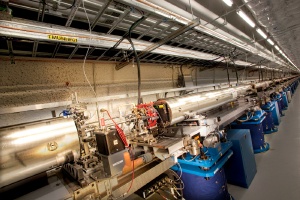Apr 21 2009
The world's brightest X-ray source sprang to life last week at the U.S. Department of Energy's SLAC National Accelerator Laboratory. The Linac Coherent Light Source (LCLS) offers researchers the first-ever glimpse of high-energy or "hard" X-ray laser light produced in a laboratory.
 Only 12 out of a total 33 LCLS undulator magnets were needed to create the first pulses of laser light. (Photo: Brad Plummer. Click for larger image.)
Only 12 out of a total 33 LCLS undulator magnets were needed to create the first pulses of laser light. (Photo: Brad Plummer. Click for larger image.)
When fine tuning is complete, the LCLS will provide the world's brightest, shortest pulses of laser X-rays for scientific study. It will give scientists an unprecedented tool for studying and understanding the arrangement of atoms in materials such as metals, semiconductors, ceramics, polymers, catalysts, plastics, and biological molecules, with wide-ranging impact on advanced energy research and other fields.
"This milestone establishes proof-of-concept for this incredible machine, the first of its kind," said SLAC Director Persis Drell. "The LCLS team overcame unprecedented technical challenges to make this happen, and their work will enable frontier research in a host of fields. For some disciplines, this tool will be as important to the future as the microscope has been to the past."
Even in these initial stages of operation, the LCLS X-ray beam is brighter than any other human-made source of short-pulse, hard X-rays. Initial tests produced laser light with a wavelength of 1.5 Angstroms, or 0.15 nanometers—the shortest-wavelength, highest-energy X-rays ever created by any laser. To generate that light, the team had to align the electron beam with extreme precision. The beam cannot deviate from a straight line by more than about 5 micrometers per 5 meters—an astounding feat of engineering.
"This is the most difficult lightsource that has ever been turned on," said LCLS Construction Project Director John Galayda. "It's on the boundary between the impossible and possible, and within two hours of start-up these guys had it right on."
Unlike conventional lasers, which use mirrored cavities to amplify light, the LCLS is a free-electron laser, creating light using free-flying electrons in a vacuum. The LCLS uses the final third of SLAC's two-mile linear accelerator to drive electrons to high energy and through an array of "undulator" magnets that steer the electrons rapidly back and forth, generating a brilliant beam of coordinated X-rays. In last week's milestone, LCLS scientists used only 12 of an eventual 33 undulator magnets to generate the facility's first laser light.
The LCLS team is now honing the machine's performance to achieve the beam quality needed for the first scientific experiments, slated to begin in September. With its ultra-bright, ultrafast pulses, the LCLS will work much like a high-speed camera, capturing images of atoms and molecules in action. By stringing together many such images, researchers will create stop-motion movies that reveal the fundamental behavior of atoms and molecules on unprecedented timescales.
"The LCLS team saw a vision of a remarkable new tool for science that could be achieved by using the existing SLAC linear accelerator, and they delivered on that vision with remarkable speed and precision," said DOE Office of Science Acting Director Patricia Dehmer. "The science that will come from the LCLS will be as astounding and as unexpected as was the science that came from the lasers of a few decades ago. We do not yet know all that the LCLS will reveal about the world around us. But we can be sure that the new results will excite and energize the scientific communities that we serve."
For additional materials, please see the Fact Sheet, Image Gallery, and Video Interviews.
The LCLS project is a DOE Office of Science-funded collaboration among several DOE National Laboratories, including SLAC National Accelerator Laboratory and Argonne, Lawrence Berkeley, and Lawrence Livermore National Laboratories; and Cornell University and the University of California, Los Angeles. Pacific Northwest National Laboratory provided additional project management which helped make this project successful.
SLAC National Accelerator Laboratory is a multi-program laboratory exploring frontier questions in photon science, astrophysics, particle physics and accelerator research. Located in Menlo Park, California, SLAC is operated by Stanford University for the U.S. Department of Energy Office of Science.